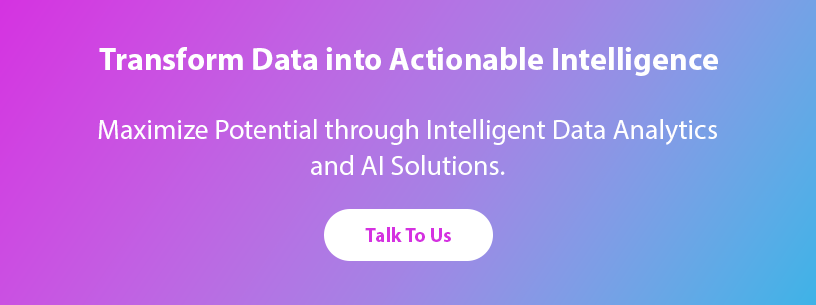Data and Predictive Analytics have made a quantum leap forward in recent years. Data is generated by everything from traffic sensors, cameras to heart rate monitors, enabling better insights into human and “thing” behavior. As a result, data has become the new corporate asset – and the best way for companies to generate insights and digitize everything they do.
However, the volume of data is increasing, and entrepreneurs are struggling to identify and retrieve relevant insight from indecipherable data. Various cognitive algorithms have been developed and computational power and storage have steadily improved, yet the analytics process remains manual and prone to bias.
Relying on a data scientist to manually build and manage models to explore every possible combination and pattern can result in incorrect or incomplete fallouts, adversely affecting key business decisions.
Just like the rise of Uber disrupting the traditional taxi business – disruptive innovations are taking place in the data analytics realm today. Disruptive innovation means modernizing the traditional way people do things. It is a fundamental change that makes old things obsolete.
As we can see, the first wave of disruption in data analytics i.e., the coding-based data analytics platform is transformed into a visual-based platform – the second wave of disruption. Along with this, the era of modern business intelligence evolved, where data are visualized in an interactive and code-free environment and hence realizing true business value.
Now, we are on a new horizon of “Augmented Analytics”. Augmented Analytics is one of the top trends in the data and analytics field that has significant potential to disrupt traditional businesses soon.
According to Gartner – These are the top 10 data and analytics trends that will drive the advancement of analytics over the next few years.
- Augmented Analytics
- Augmented Data Management
- Continuous Intelligence
- Explainable AI
- Graph
- Data Fabric
- Natural Language Processing
- Commercial AI and Machine Learning
- Blockchain
- Persistent Memory Servers
This latest data-driven analytics solution uses AI and ML techniques, as well as natural language processing to automate many time-consuming tasks and eliminate the interpretation bias of current manual approaches; overall changing the way companies create, interpret and share data.
It also has the capability of executing several queries on billions of data with dozens of algorithms to uncover anomalies and visualize trends.
The basic concept of augmented analytics is to assist businesspeople in extracting valuable information, speed up repetitive tasks and enable businesses to take faster and smarter decisions.
For example, Cygnet Digital assisted the client by using an Artificial Intelligence algorithm – Naive Bayes Classification to analyze data from online reviews and understand the sentiment of customers which helped the client in improving the quality of services and increase customer satisfaction.
How augmented analytics can impact your organization
- More Relevant Insights and Correlation: Augmented analytics helps in identifying more meaningful correlations by applying a range of algorithms and machine learning abilities. It can also automate and speed up the process of finding relevant insights from the data which saves a huge amount of time; optimizing the resulting decisions and actions. This reduces the risk of missing important information from the data.
- Optimizes Productivity: Manually performing data preparation is a cumbersome and complex process. Augmented analytics automates repetitive and time-consuming tasks which increase overall human productivity. It also accelerates the process of tasks in such a manner that every entrepreneur can take business decisions efficiently.
- Democratizes Data Analytics: Augmented analytics tends to run 8 to 10 algorithms on the data to automatically detect patterns and extract information. Through this process, augmented analytics democratizes the insights, allowing business users to extract complex insights easily reducing their significant time in doing so. Using augmented analytics, data scientists will no longer need to determine a suitable algorithm or write code manually to obtain results.
- Easy Adoption of Actionable Insights: After the data patterns are determined, the results can be easily communicated with the internal team in the organization. Augmented analytics tool reads the chart or report and interprets the information into human language. For example, you are losing market share to competitor X. A business user can also ask “How does our market share compare with our competitors? “This way augmented analytics addresses behind-the-scenes complexities, simplifying the data analytics process, improving data-driven decision-making and adoption across the entire organization.
Conclusion
Integration of Artificial Intelligence (AI) and Data Analytics has transformed the way businesses operate. With the emergence of Augmented Analytics, businesses can access deeper insights, optimize productivity and democratize data analytics. The technology can automate repetitive tasks, eliminate interpretation bias, and execute several queries on billions of data to uncover anomalies and visualize trends. As we move towards a data-driven world, Augmented Analytics has significant potential to disrupt traditional businesses. As such, it is crucial for businesses to adopt this technology to gain a competitive edge, improve data-driven decision-making, and drive success in the modern business landscape.
For a better understanding of innovative technologies like AI and Data, get in touch with our experts. Stay ahead of the competition with leading technology providers like Cygnet Digital.











